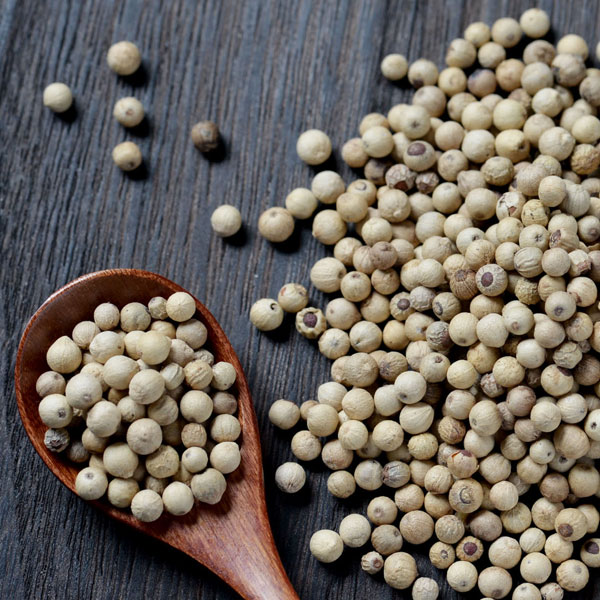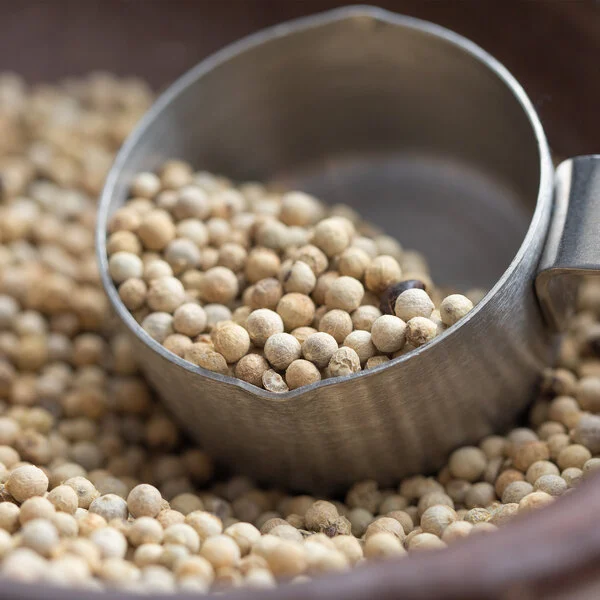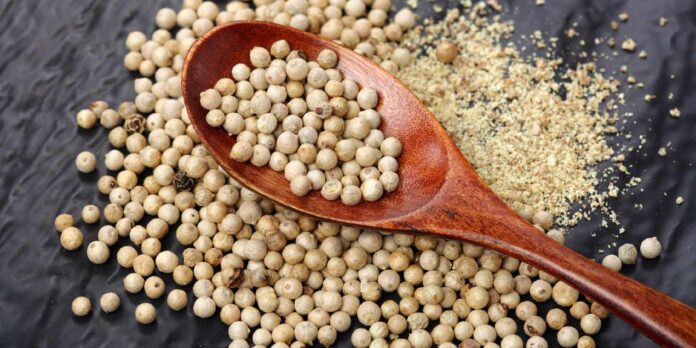Introduction to White Pepper
White pepper (Piper nigrum) is a popular spice derived from the dried ripe berries of the pepper plant, the same plant that produces black pepper. The key difference between white and black pepper lies in the processing method. While black pepper is made by drying the whole unripe berry, white pepper is produced by removing the outer dark skin of the ripe berry, leaving only the inner seed.This process gives white pepper a milder flavor and lighter color compared to black pepper. It is often described as having a subtler, earthy, and slightly fermented taste, making it ideal for dishes where a strong peppery aroma or dark specks are not desired such as in white sauces, soups, mashed potatoes, and seafood dishes.

English: White Pepper
Hindi: Safed Mirch (सफ़ेद मिर्च)
Urdu: Safed Mirch (سفید مرچ)
Tamil: Vellai Milagu (வெள்ளை மிளகு)
Telugu: Tella Miriyalu (తెల్ల మిరియాలు)
Malayalam: Vella Mulaku (വെള്ള മുളക്)
Kannada: Bili Menasu (ಬಿಳಿ ಮೆಣಸು)
Bengali: Sada Golmorich (সাদা গোলমরিচ)
Arabic: Filfil Abyad (فلفل أبيض)
HEALTH BENEFITS:

Aids digestion:
White pepper may help stimulate appetite and improve digestion by promoting the secretion of hydrochloric acid in the stomach. This can provide relief from bloating, flatulence, and indigestion.
Rich in antioxidants:
Like black pepper, white pepper is a good source of antioxidants. These compounds help combat free radicals, protecting your body from oxidative stress and reducing the risk of chronic diseases.
Reduces inflammation:
Piperine, the key compound in pepper, has natural anti-inflammatory properties. Some research suggests it may help reduce inflammation in the body and ease pain associated with conditions like arthritis.
Clears congestion:
White pepper has a warming effect that can help clear nasal passages and relieve chest congestion. It is often used in home remedies for coughs, colds, and sore throats.
Supports heart health:
Some evidence suggests piperine may help reduce cholesterol buildup in arteries and improve blood circulation. This, along with its antioxidant properties, can contribute to overall cardiovascular health.
Enhances nutrient absorption:
Piperine is well-known for its ability to increase the bioavailability of other nutrients, particularly curcumin from turmeric. This helps your body make better use of the beneficial compounds in your food.
Promotes skin health:
Stimulates melanocytes to produce pigment, which can be beneficial for conditions like vitiligo. It can also help improve dental health.
May lower blood pressure:
Some studies suggest a link between white pepper and reduced blood pressure.
SIDE EFFECTS:

Digestive issues:
Can cause heartburn, gastric discomfort, or irritation, especially when consumed in large amounts.
Allergic reactions:
Though rare, some individuals may experience an allergic reaction.
Irritation from inhalation:
Inhaling fine pepper powder can cause a burning sensation, coughing, sneezing, or a runny nose.
Drug interactions:
Piperine can interfere with how the body metabolizes certain medications. It is important to consult a doctor before taking supplements or large amounts if you are on prescription drugs.
HOW TO USE:
1. Culinary Uses

In Light-Colored Dishes:
White pepper is often used in dishes where black pepper would leave dark specks. It enhances flavor without changing the color of the food.
Examples:
Cream soups (like mushroom or cauliflower soup)
White sauces (such as Alfredo or béchamel sauce)
Mashed potatoes and cream-based gravies
In Asian Cuisine:
White pepper is a staple in Chinese, Thai, and Vietnamese cooking. It gives a gentle heat and unique aroma.
Common uses include:
Stir-fried vegetables or noodles
Hot and sour soup
Fried rice
Dumpling fillings and marinades
2. Medicinal and Health Uses
White pepper contains piperine, which may have several health benefits when used moderately:
Aids Digestion: Stimulates digestive juices and reduces bloating.
Relieves Cold and Cough: Mixed with honey or warm water, it can help clear nasal congestion.
Improves Appetite: Often used in traditional remedies to boost appetite and metabolism.
Anti-inflammatory Properties: May help reduce joint pain and inflammation.
(Note: Always use small quantities; excessive intake can cause irritation or acidity.)
3. Storage and Preservation
Store white pepper in an airtight container away from light and moisture.
Keep it in a cool, dry place to preserve its aroma and flavor.
Whole white peppercorns last longer than ground white pepper; grind only as needed.
Tips for Best Use
Add white pepper toward the end of cooking to maintain its aroma.
Avoid overheating it in oil — it can develop a slightly bitter taste.
Always use a clean, dry spoon to prevent clumping.




